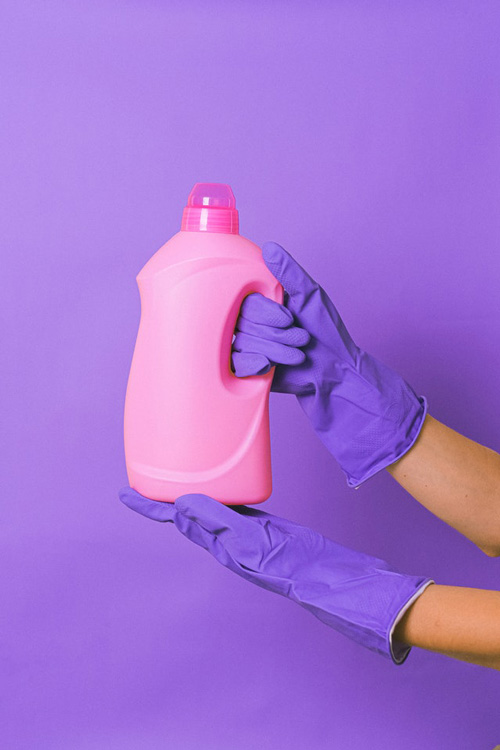You have a modern kitchen filled with your favorite appliances, and yet you reach for the stovetop every time.
While the air fryer and slow cooker create delicious meals, nothing beats the induction cooktop when it comes to making quick, easy and varied recipes.
Your induction cooktop is flat and similar to an electric cooktop but there is a difference in the way they produce heat for cooking. While electric ones heat up an electric coil, your induction uses electromagnetic current (through a copper wire placed under the surface) to heat up.
This appliance heats fast, cooks faster but efficiently, and cools down quickly. You can make meals in less time and save energy in the process. As the hot surface is the one in contact with the steel or cast-iron utensil, there is low risk of getting burnt, and absolutely no worrying about gas leaks.
But when the cooking is over, it’s time to clean up. You do the dishes but somehow neglect the cooktop. Until you cannot ignore the accumulated stains and grease.
You can easily clean an induction cooktop and in the same way you would an electric stovetop. The added advantage is that it doesn’t take a long time to cool down. Of course, remember to turn it off and wait for a couple of minutes before you start cleaning.
Why Should You Clean The Induction Cooktop?
Like every other appliance, induction cooktops need a bit of TLC to work efficiently. To keep it in prime condition and retain the glassy shine (the one you feel in love with), you need to give it a regular clean up.
How Do You Keep Induction Cooktop Clean Every Day?

All you have to do is to let the cooktop cool down and wipe it with a soft cloth. Use a damp cloth if there are food particles stuck to the glass top.
Doing this everyday ensures that dirt, spilled food, and grease does not accumulate over the cooktop. If your induction has a buildup of dirt and oil, it may prevent the burners from working properly.
This technique works when the cooking surface is relatively clean with no spills or splattered food sticking to the top.
Despite our best intentions and being careful, spills and splutters happen while frying or cooking.
What do you do when you’ve spilled milk, oil or sauce on the cooktop?
There are various methods and products available for cleaning these cooktops. But this depends on what kind of stain or sticky food you’re trying to remove.
Before we get to the nitty gritty of cleaning, let’s look at the items and materials you should avoid using on your glass cooktop whether its is induction or electric.
Which Cleaners Should You Avoid Using On Induction Cooktop?
- If you plan on using window cleaners because your cooktop is made of glass, stop right there! Window glass and cooktop glass are totally different products. The toughened glass used on windows can tolerate the use of strong cleaners with chemicals.
Your induction cooktop is built from ceramic glass that reacts to ammonia-based cleaners (used on window glass). When you use these on your cooktop, you will end with staining it further and worse still, damaging the surface.
- You might inadvertently damage your induction cooktop by using certain materials. Avoid abrasives like coarse scrubbers, steel wool, abrasive brushes or cloth that can leave starches and stains on the surface.
- If you think chlorine or alcohol products are safe for use on the cooktop, sorry to say that they are not! While these are meant to remove stains, chlorine and ethanol can prove too strong for the glass surface and stain it further.
Now that you know what to avoid, time to find out how to clean different stains and spills and what to use in each scenario.
How To Clean Mild Stains On Induction Cooktop
If you clean the cooktop every day, then you don’t have to contend with oily residue, crumbs, or dried and burnt-on food particles. When you clean as soon as you’ve spilled something or finished cooking, then you reduce the chance of liquid drying up and leaving a stain.
Similarly cleaning the cooking surface after you’ve used the fryer or frying pan prevents the grease from sticking and leaving an unsightly residue.
For smudges and liquid spills, all you need is soap water and a soft sponge. Avoid using harsh detergents. Contain the spill with a soft cloth first. Fill a spray bottle with dishwasher liquid mixed with water. Spritz this on the ceramic glass top and wipe with a sponge.
The other option is to use white vinegar. If you don’t have it on hand, you may be tempted to use other vinegars, but avoid these. Other vinegar could worsen the problem and lead to more stains.
As with soap water, keep a spray bottle filled with diluted white vinegar. and gently spray it on the glass top. Then wipe down the surface with a damp cloth or sponge.
If your induction cooktop comes with a ceramic-cleaning product, feel free to use that for stronger stains and grease build up.
This enables you to keep the cooktop clean and shiny without damaging the surface.

How To Clean Sticky Food On The Induction Cooktop?
You’re busy chatting on the phone one minute and your stew or soup bubbles over in the next leaving a messy trail of liquids and solids.
If you don’t clean immediately the wet foods could stick to the surface. Soap water and vinegar are unlikely to work on these kinds of spills.
For sticky messes, clean the affected area with a wet sponge and then use an approved cleaner. Finish it off with a sponge or soft cloth.
You can use toothpaste in a similar way to clean smudges and stains from sticky food.
How To Clean Oil Residue And Dried Food On The Induction Cooktop?
You often cook multiple meals on the cooktop during the weekend or when we have parties at home. Spills and messes are to be expected, especially when you have two or more people handling the cooking
Dried and oil residue are tough beasts that require more work on your part.
First thing first. Wipe the area with a damp sponge. You should scrape off the dried food or residue as best as you can. Then use a plastic or silicone scraper (cake frosting scraper works well).
Hold it at a low angle to the surface to prevent starches on the cooktop, and remove the dried food or residue. After you’ve removed the food particles, use a cleaner over the surface. Finish up with a damn sponge.

How To Clean Burnt Food On The Induction Cooktop?
In addition to ceramic cleaners, a combination of vinegar and baking soda helps remove tough stains and burnt food particles from the cooktop.
Make a solution with equal amounts of white vinegar and water. Rub it on the induction surface and leave it for a few minutes to release the crumbs.
Wipe with a damp sponge or eraser pad. Now spread a little baking soda or hydrogen peroxide on that particular spot. Wait it for 15-20 minutes before you wipe it away with a soft damp cloth or soft cleaning scrub area.
How To Clean Hard Water Stains From The Cooktop?
Distilled white vinegar to the rescue.
If you live in a place with hard water, you’ll notice mineral stains on the surface with regular use.
Spray or dab vinegar over the entire surface and leave it for a few minutes. Remove the vinegar with a damp cloth or soft brush. Wipe down once more with a damp sponge.
For tougher hard water stains, use a melamine foam eraser along with vinegar.
Top this up with a special cleaning cream meant for glass cooktop. Spread the cream over the stained surface with a soft brush or a toothbrush and leave it for 10 minutes. Use a dry cloth to remove the cream.

What To Clean White Marks From The Cooktop?
After a couple of years of use, you’ll start seeing white marks on the cooktop surface. These are scratches (tiny holes) accumulated over the years with the use of cookware and metal ladles
Soap water, white vinegar and even your cleaning creams are ineffective here. You need a non-abrasive cleaning powder to fill the micro holes and render them invisible.
Make sure the powder you use doesn’t have any silica, quartz or feldspar or calcite in it. These can worsen the scratches by adding more of their own.
You may notice dull, white marks on the surface of the cooktop if you've used it for a few years. These are actually tiny scratches, not stains, so vinegar and ceramic cleaner won't be very effective.
Spritz water on the cooktop and sprinkle non-abrasive cleaning powder over it. Use a soft cloth to rub the product in. Then, take a damp cloth and wipe it clean.
How To Clean Other Parts Of Induction Cooktop?
While the cooking surface is made with ceramic glass, the induction has stainless steel parts. Cleaning this is an easy process.
Spray with soap water and wipe clean with a non-abrasive scrubber.
For other parts of the induction which are not glass-like (such as), use soapy water and a toothbrush or soft cloth.
How Do I Prevent Scratches On My Induction Cooktop?
The induction has a glass cooktop with a quartz layer which is prone to marks on rough use.
You can prevent or minimize these. Avoid sliding your cookware (especially cast iron) or bowls across the surface or from one burner rot the burner. Lift and place the utensil on the burner instead.
You could end up creating fresh marks while cleaning. Go gentle with sponges and cleaners, especially when using scrapers. Don’t reach for the knife or other sharp tools while removing stubborn stains and grime.
There you have it. Various methods and products to keep your induction cooktop looking shiny and brand new. Use the method suitable for your specific stains or food spillage problem.
Remember having a clean cooktop is good hygiene practice and makes cooking a joy!
Do you have a special cleaning method to maintain the shine of your induction cooktop? Let us know in the comments.

